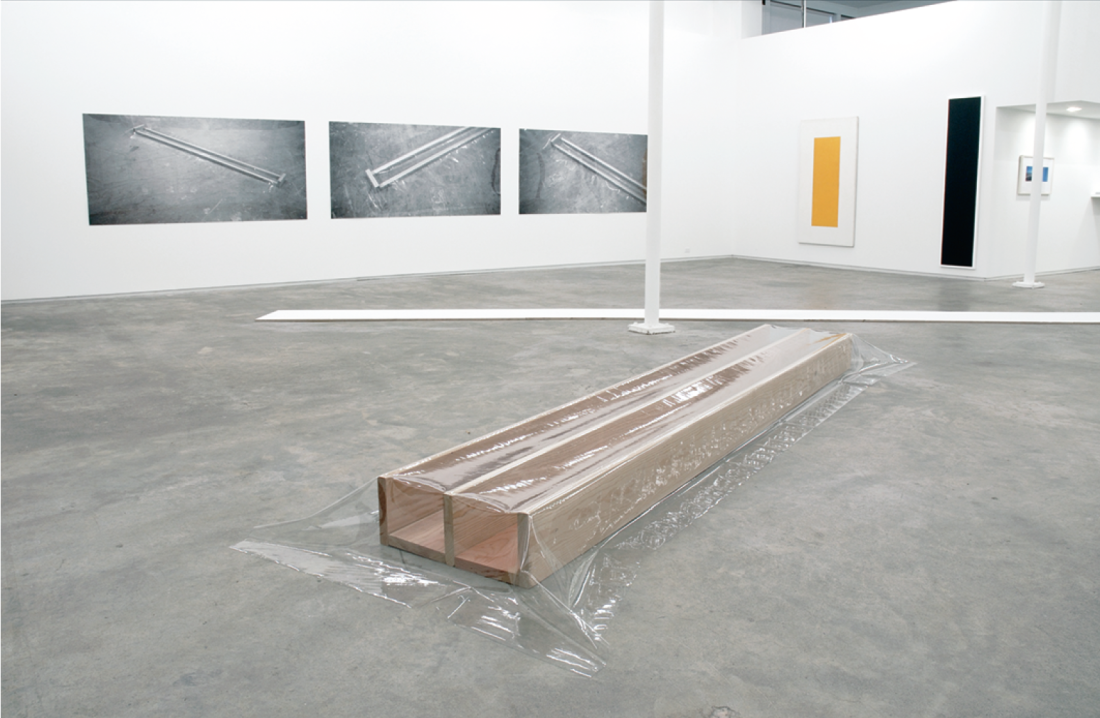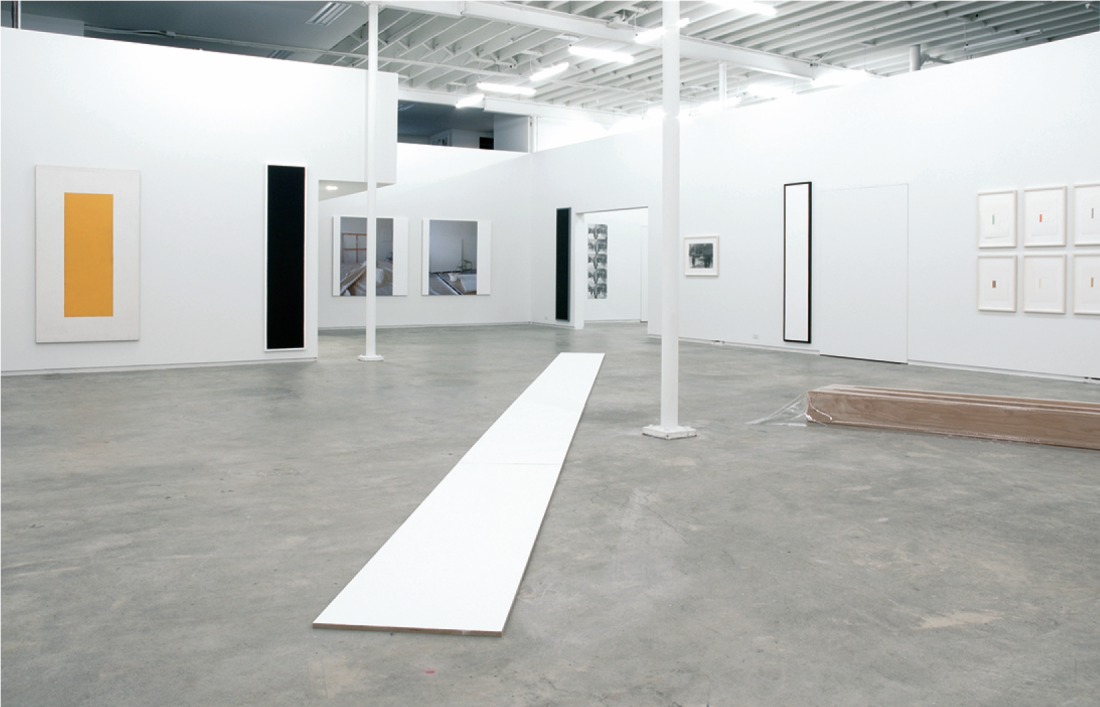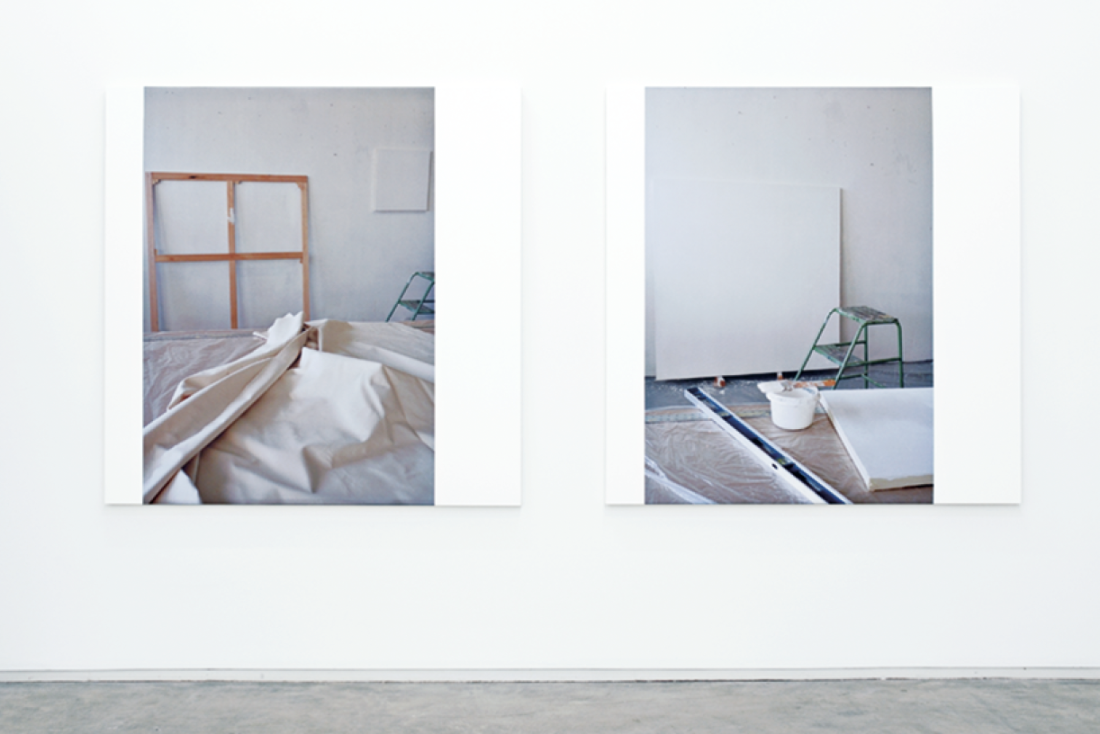Ian Wallace
“What’s old is new again” was a refrain that ran throughout Ian Wallace’s recent exhibition at Catriona Jeffries Gallery in Vancouver. In what could have been a stroll down memory lane, this show, bookending the past 40 years of the artist’s career, 1967– 2007, actually came off as a fascinating encounter with Wallace’s formative early work and issues emblematic of abstraction and conceptual art. A number of the works in the exhibition were redone; for example, Untitled (Plank Piece), 1969/2007, which was originally constructed from standard building-supply materials for a show at the Musée des beaux-arts de Montréal in 1969, and which was predated, in a sense, by Wallace’s installation of floor-bound planks and clear vinyl at the UBC Fine Arts Gallery in 1968. The fortuitous origins of Untitled (Plank Piece) occurred as Wallace was in his studio, preparing stretcher bars for a series of vertical monochrome paintings (some recreated for this exhibition), and was struck by the interesting sculptural quality of the lengths of wood positioned on the floor. Substituting clear vinyl for canvas, he undertook a number of experiments, draping the pliable, transparent material over sections of wood, then he photographed the results.

Ian Wallace, installation view, Catriona Jeffries Gallery, October/ November 2007. Photo: Scott Massey. Courtesy Catriona Jeffries Gallery, Vancouver.
The artist acknowledges he began to be very interested in documenting process about this time, and the black and white light jet prints in the exhibition, called Untitled, 1968/2007, recreated from three photographs from this early studio series, evidenced the beginnings of what is now one of the hallmarks of his practice. Wallace’s preoccupation with the documentation of artistic process was addressed in depth in another recent exhibition called “In the Studio.” In his catalogue essay for that show, Wallace admitted that while attempting to link the many references to process— technical, conceptual, symbolic, literary, temporal, et cetera—that are actually associated with the construction of a work, “I was creating a dramatized form of intellectual montage.” In studying his work, it becomes apparent that his methodology, indeed his philosophy, is not defined by in-the-studio, out-of-the-studio or post-studio per se, but rather by the conceptual and creative mobility of his art practice.

Ian Wallace, installation view, Catriona Jeffries, Vancouver. In this image, left to right: Untitled (White Monochrome with Orange Rectangle), 1968, Untitled (Black Monochrome with White), 1967/2007, Support/ Surface I, II, 2007, Untitled (White Line), 1969, 2007 version, Untitled (Plank Piece), 1969/2007.
Untitled (Plank Piece) is undeniably a successful abstract sculpture in mass, scale, placement and materials. Not paradoxically, it is the cryptic reference to stretcher bars and canvas that points to the conceptual content of the piece, which is, to paraphrase the artist, the idea that the foundation of painting, or art for that matter, is what it is at its most minimum state. By description, Untitled (Plank Piece) consists of five, two- by-ten-by-twelve-foot fir planks arranged in a tight configuration, three on edge, two laid flat on the floor, with a transparent vinyl membrane slung over top. The vinyl’s entropic sag partway into the two channels emphasizes sculptural concreteness or literality, and conceptually points to its opposing state, which, in this case, is the taut and flat painting support ground or surface.

Ian Wallace, Support/Surface I, II, 2007, diptych, 2 photolaminate and acrylic on canvas, 60 x 60” each, total installation 60 x 132”. Photo: Scott Massey. Courtesy Catriona Jeffries Gallery, Vancouver.
The “mobility” of Wallace’s art practice is nowhere more evident than in the relationship between Untitled (Plank Piece) and Support/ Surface I, II, 2007, but it would be simplistic to assume that a diachronic development of his practice over 40 years has determined the connectivity between the two. It is more likely the artist’s ongoing interrogation of the limits of art that informs the reflexiveness common to, and between, these two works and in his oeuvre as a whole. Support/Surface I, II is a photo laminate and acrylic on canvas diptych whose visual subject describes the contents (sans paint) of a painter’s studio: unfurled and stretched canvases, canvas stretcher, primer bucket and brush, carpenter’s level, step-stool, and metre stick. Jointly, the two pictures imply a state of pre-production; however, the left diptych panel includes a stretched and primed canvas on the wall, presumably placed there in readiness for a painting session, which, in a post-easel era, is not uncommon. Yet this canvas is “easel size,” which leads to the question of whether this painting is in fact finished—a white monochrome. The formal associations with Untitled (Plank Piece) are articulated through materials and tools, and conceptually by questioning the limits of art, the end game if you will, that requires art be reduced to its most minimum state so that its very identity becomes a question. In part, what we’re looking at in this artful studio documentation is a representation of a monochrome in the guise of a primed canvas; that is, a foundation for painting, or perhaps, more accurately, a representation of painting reduced to its foundations. ■
“Ian Wallace” was exhibited at Catriona Jeffries Gallery in Vancouver from October 18 to November 17, 2007.
Gary Pearson is an artist and Associate Professor at UBC Okanagan in Kelowna, British Columbia.

